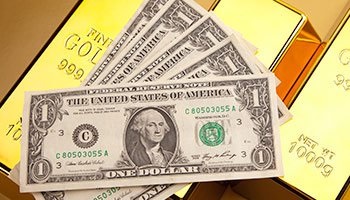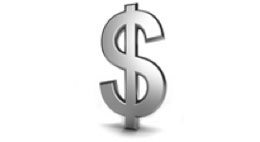One of the chief virtues of a gold standard is that it serves as a restraint on the growth of money and credit. It makes runaway government deficit spending and major monetary catastrophes such as hyperinflation practically impossible. Opponents of a gold standard can’t defend the political malpractices that are enabled by a fiat currency regime. So instead they spin a narrative about how gold supposedly hampers the economy. According to Keynesian economics, spending boosts the economy while savings contracts it. Keynesians put the cart before the horse. Savings and investment drive the economic productivity that enable consumers to enjoy a high standard of living. But Keynesians believe the economy only booms when demand is artificially pumped up by debt, government spending programs, and perpetual currency depreciation (inflation) engineered by central bankers. A gold standard produces deflation, its opponents charge, which incentivizes consumers to save money rather than spend it. Of course, what they call “deflation” is really just price stability. Over time, gold (and gold-backed money) maintains its purchasing power – neither gaining nor losing real value against other raw materials. When the U.S. pursued sound money policies from the post Civil War period into the early 1900s, consumer price levels were virtually flat; yet real economic growth soared.
Topics:
Stefan Gleason considers the following as important: Dow Jones, Featured, Gold and Silver as Money, Gold Standard, James Rickards, Keynesian, Murray Rothbard, newsletter, silver standard
This could be interesting, too:
Nachrichten Ticker - www.finanzen.ch writes Die Performance der Kryptowährungen in KW 9: Das hat sich bei Bitcoin, Ether & Co. getan
Nachrichten Ticker - www.finanzen.ch writes Wer verbirgt sich hinter der Ethereum-Technologie?
Martin Hartmann writes Eine Analyse nach den Lehren von Milton Friedman
Marc Chandler writes March 2025 Monthly
 One of the chief virtues of a gold standard is that it serves as a restraint on the growth of money and credit. It makes runaway government deficit spending and major monetary catastrophes such as hyperinflation practically impossible.
One of the chief virtues of a gold standard is that it serves as a restraint on the growth of money and credit. It makes runaway government deficit spending and major monetary catastrophes such as hyperinflation practically impossible.
Opponents of a gold standard can’t defend the political malpractices that are enabled by a fiat currency regime. So instead they spin a narrative about how gold supposedly hampers the economy.
According to Keynesian economics, spending boosts the economy while savings contracts it.
 Keynesians put the cart before the horse. Savings and investment drive the economic productivity that enable consumers to enjoy a high standard of living. But Keynesians believe the economy only booms when demand is artificially pumped up by debt, government spending programs, and perpetual currency depreciation (inflation) engineered by central bankers.
Keynesians put the cart before the horse. Savings and investment drive the economic productivity that enable consumers to enjoy a high standard of living. But Keynesians believe the economy only booms when demand is artificially pumped up by debt, government spending programs, and perpetual currency depreciation (inflation) engineered by central bankers.
A gold standard produces deflation, its opponents charge, which incentivizes consumers to save money rather than spend it. Of course, what they call “deflation” is really just price stability. Over time, gold (and gold-backed money) maintains its purchasing power – neither gaining nor losing real value against other raw materials. When the U.S. pursued sound money policies from the post Civil War period into the early 1900s, consumer price levels were virtually flat; yet real economic growth soared. The Great Depression was caused not by gold but by a series of policy blunders from the recently established Federal Reserve.
The claim that people pull back on consumption when their currency retains value is a red herring. The real distinction between sound gold money and inflationary fiat money is that under a sound dollar, individuals (and governments) are less apt to take on large debt loads. The reason why debt is so alluring under an inflationary monetary system is that the real value of an existing debt gets eaten away over time.
Inflationary fiat money is a tool for governments, banks, and Wall Street to siphon off greater shares of the economy.
When a currency is in the process of losing value, people are effectively taxed by holding it. So they deposit their cash into banks, hoping to earn enough interest to offset some of their inflation loss. Or they speculate on assets such as stocks which might (or might not) best inflation. Or they take out mortgages on houses, hoping home values will rise faster than their interest rate (and paying loan origination fees to banks for the privilege).
SILLY MYTH: “There’s Not Enough Gold Available Anymore to Back the Currency!”
Another, more recent, argument against reintroducing a gold standard is that there isn’t enough gold.
It’s true that there isn’t enough gold available at current prices to back all the dollars in circulation in the $18 trillion U.S. economy. But if gold were revalued at a significantly higher price, the supposed supply problem would be solved.
 Put another way, gold is underpriced at $1,300/oz. According to monetary historian, economist, and gold advocate James Rickards, a more realistic gold price would be $10,000/oz. At that price, he argues, a gold standard would be feasible (based on a calculation of 40% of money supply divided by official gold holdings).
Put another way, gold is underpriced at $1,300/oz. According to monetary historian, economist, and gold advocate James Rickards, a more realistic gold price would be $10,000/oz. At that price, he argues, a gold standard would be feasible (based on a calculation of 40% of money supply divided by official gold holdings).
Other sound money advocates say that true 100% gold backing would require a gold price north of $20,000.
The idea that gold could be revalued to $10,000 – $20,000/oz might seem far-fetched to some. But it’s no less fundamentally justified than the Dow Jones at 10,000 – 20,000. Nor would a gold price equal to the Dow be unprecedented.
In fact, back in January 1980, the gold price spiked up to parity with the Dow. The Dow currently trades at close to 18,000. Were a new gold standard to be instituted today, $18,000 might be a sensible target price for gold.
Gold and Silver and a Freely Fluctuating Exchange Rate
Ideally, the free market would determine the appropriate price of gold and its status within the monetary system. Here is free-market economist Murray Rothbard’s take, from his book What Has Government Done to Our Money?:
“What kind of ‘standard’ will a free money provide? The important thing is that the standard not be imposed by government decree. If left to itself, the market may establish gold as a single money (‘gold standard’), silver as a single money (‘silver standard’), or, perhaps most likely, both as moneys with freely fluctuating exchange rates (‘parallel standards’).”
Silver is more practical than gold as a transactional currency among the masses due to gold’s steep value (even at current prices). For that same reason, gold is more practical than silver as a reserve asset for commercial banks and central banks.
 Out of 92 basic elements, gold is one of only four that meet all the criteria for money. And by tradition, gold is the metal universally recognized as the ultimate money.
Out of 92 basic elements, gold is one of only four that meet all the criteria for money. And by tradition, gold is the metal universally recognized as the ultimate money.
A gold revaluation might be brought about by the free market through the emergency of competing private currencies. Or it could be spearheaded by a sound money movement in Congress, which is very much an uphill battle given politicians’ addiction to growing the debt.
Some sound money proponents are more optimistic about a gold-backed Chinese yuan. The Chinese are the world’s biggest gold producers and consumers, and the People’s Bank of China is rapidly ascending up the ranks of the world’s biggest gold reserves.
Official gold standard or not, the metal of kings will continue to serve its function as a universally recognized, inflation-proof money.
